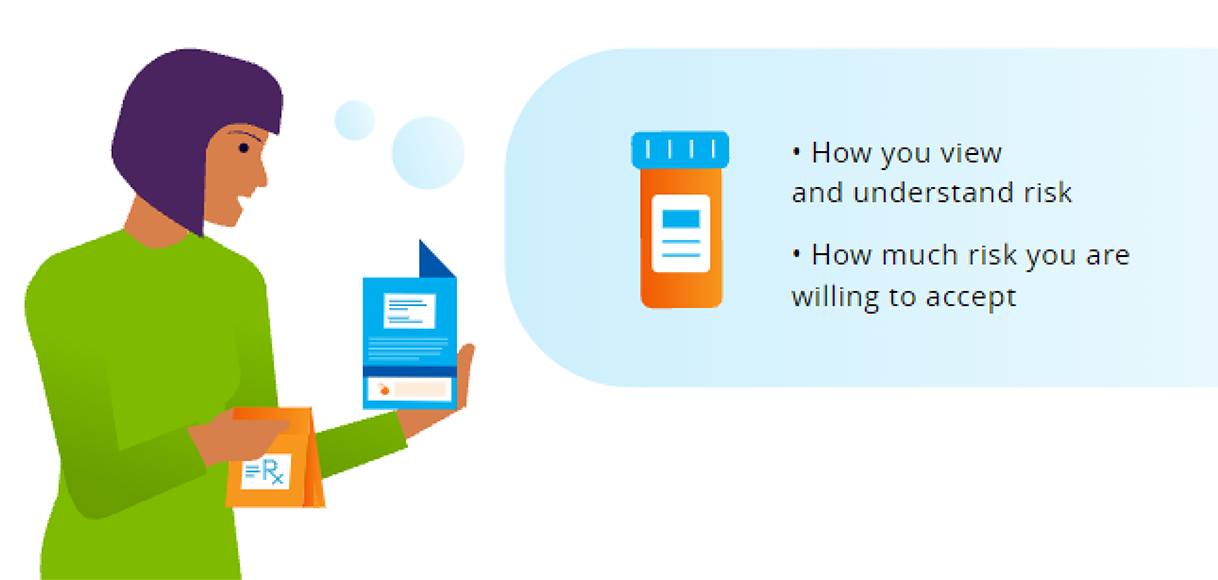Making good treatment choices
How do people decide whether or not to take a medicine?
When patients and healthcare providers think through the available treatment options, they consider the benefits and risks of each option. Benefits are the favorable effects and risks are the unfavorable effects. It is also important to understand how likely a patient is to experience any of these effects.
Making good treatment choices with your healthcare team
Understand the benefits and risks of medicines1


All medicines have benefits and risks. 2
Benefits of a medicine are favorable effects and risks of a medicine are unfavorable effects that can happern when you take a medicine. 2

- Benefits of taking a medicine might include, for example
- Improving sleep
- Treating an infection
- Preventing a heart attack
- Risks of taking a medicine might be, for example
- Mild like most headaches
- More serious like kidney damage
- And, rarely, death
When your healthcare team talks about the benefits and risks of your medicine, they use the product information to help you make good choices about your treatment options.
There are potential risks if you do not take medicine as prescribed. 2
Taking medicines incorrectly can interfere with the ability of medicines to treat many diseases. 3
You and your healthcare team must always weight the benefits and risks in order to choose the treatment that is right for you.

Test your risk for heart disease with this short quiz.
This is just an example showing how different people may have different risks. 4
Click here to take the quiz
DetailsViewing Risk
Viewing Risk
People may thing of risk differently. 5
Would you feel safe...

The way you think about these and other activities
may be different from how other people think about them.
It depends on many things such as: 6

Understand Medicine Risk
Understanding your risk 7,8
Understanding benefits and risks can help you make important decisions about your health and treatment.
Imagine reading this headline online or in a newspaper:

That may be alarming at first glance — but what if the headline said:

Both headlines are talking about the same event.
The first headline is describing a relative risk, which examines the risk of an event happening to people who take a medicine compared to those who do not.
As you can see, relative risk and absolute risk are two different ways of looking at risk.

You and your healthcare team should discuss absolute and relative risk as they apply to you.

Your risk of a side effect may be different from someone else who is taking the same medicine. 9 For example, some medicines have a greater risk of side effects among older adults.
It is important to talk with your healthcare team about your risks with a medicine. 10
Take action
When you meet with your healthcare team take action by asking these questions: 11

What are my treatment options?

What are the benefits and risks of each option?

What might happen if I wait to take this medicine or take no medicine?

What are the chances that these benefits and risks will happen to me?

Tell your healthcare team what risks and benefits are most important to you.
For more about communicating benefit and risk information
SOURCES
1www.nia.nih.gov/health/making-decisions-your-doctor
2www.fda.gov/Drugs/ResourcesForYou/ucm079492.htm
3www.fda.gov/ForConsumers/ConsumerUpdates/ucm164616.htm
4www.your-heart-health.com/en-US/risk---prevention/assess-your-risk.html
5www.nsc.org/learn/safety-knowledge/Pages/injury-facts-chart.aspx
6www.ema.europa.eu/docs/en_GB/document_library/Report/2014/12/WC500178511.pdf
7www.fda.gov/RegulatoryInformation/Guidances/ucm127509.htm
8http://ecp.acponline.org/janfeb00/primer.htm
9https://newsinhealth.nih.gov/2016/10/understanding-health-risks
10www.fda.gov/drugs/resourcesforyou/consumers/ucm143566.htm
11Shepherd et al. Three questions that patients can ask to improve the quality of information physicians give about treatment options: A cross-over trial. Pat Ed Couns 2011; 84: 379-385.


